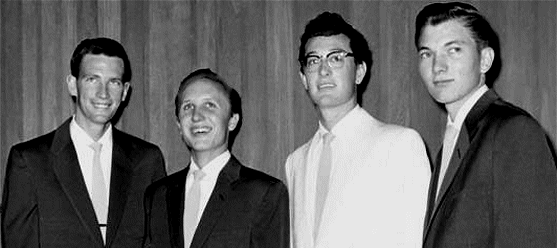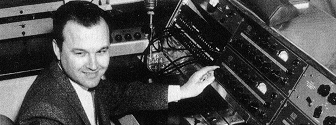Sixties
City presents
a wide-ranging series of
articles on all aspects of the Sixties, penned by the creator of the iconic
60s music paper Mersey
Beat
|
Sixties
City presents
a wide-ranging series of
articles on all aspects of the Sixties, penned by the creator of the iconic
60s music paper Mersey
Beat
|
|||||
|
| Of
the recording, Allison recalls "I messed it up the first time through, and
either Buddy or Norman said, 'Ok, if you don't get it right this time, we're
going to change it back to 'Cindy Lou'. But the second time we got it, and
it stayed 'Peggy Sue'." Funnily enough, it was Allison himself who had got
the name wrong on the first recording! On the number, Buddy displays his
familiar hiccupping style, which was actually an effect common to many vocalists
with a country music background at the time. The Coral executives actually picked 'Everyday' as the A side as they didn't believe that 'Peggy Sue' had hit potential. Common sense prevailed and 'Everyday' went on the B side - although the number was strong enough to be issued as an A side single in its own right. Apart from the stylised Holly vocal hiccup, the number is also distinguished by Allison's rapid, accented drumming and Buddy's guitar style. Commenting on Buddy's guitar work on the number, Allison said, "I've never seen anyone since who plays it that way. Every other guitar player strums it back and forth with his pick - down-up-down-up-down-up-down-up, like that. But Holly did it with just down strokes - down-down-down-down-down-down-down-down." It was sixteen to the bar and Buddy was singing at the same time. Due to the fact that Petty had insisted on being credited for songs written by Buddy, Holly didn't receive a proper songwriting credit for the number. Norman Petty claimed that Holly came to him with the tune one morning during a recording session at Clovis and that he wrote the lyrics. However, Jerry Allison was to confirm that Petty's only contribution was the chord alteration in the bridge of the song. Only Allison and Petty were listed as writers of the song until after Buddy's death, after which Jerry insisted that Buddy be given credit and that royalties of the song be more fairly distributed. He said, "After Buddy got killed, we all went to New York to straighten things out. So the contract on 'Peggy Sue' said Norman and me, and I said, 'Right, Buddy did write part of 'Peggy Sue', and he might be gone and all that, but I'm not gonna sit here and say he didn't." Petty said, "Well you can say what you want to, or you can look at the contract." Allison told him, "Well, the estate can just take my half now." It ended up with Allison getting just 10 per cent. |

|
 |
'Peggy
Sue' became the first female heroine of a rock'n'roll song and her name
lived on in other artists' compositions, including Bobby Darin's 'Splish
Splash' and 'Queen Of The Hop' and Richie Valens with 'Ooh My Head?' Jerry
Allison actually married his Peggy Sue, although they were later to be divorced.
Buddy's father then suggested the title 'Peggy Sue Got Married' to Buddy
as a possible sequel to 'Peggy Sue'. Buddy was living in New York at the
time and on January 22nd 1959 he began taping the last of a series of songs
as demo's in his apartment. Among them was 'Peggy Sue Got Married', which
was released posthumously after being overdubbed by New York musicians.
Buddy Holly's career flashed past like a shooting star in the firmament.
He was born Charles Hardin Holley on September 7th 1936 and died tragically in an air crash on February 3rd 1959. He was only 22 years old. Despite that, in his all-too-brief career, he wrote and recorded songs that have stood the test of time. Apart from 'Peggy Sue' they include 'That'll Be The Day', 'Everyday', 'Rave On', 'True Love Ways', 'Heartbeat', 'Oh Boy', 'Not Fade Away', 'Listen To Me', 'It's So Easy', 'It Doesn't Matter Anymore', 'Raining In My Heart', 'Moondreams', 'Mailman Bring Me No More Blues', 'Reminiscing', 'Brown Eyed Handsome Man', 'Maybe Baby', 'Love Is Strange' and several others. |
|
Article
Text
UK
web hosting by
|